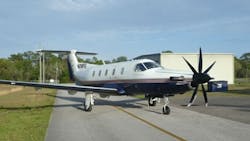World's First 7-Bladed MT-Propeller Certified on Pilatus PC-12
World's first 7-bladed Unducted Prop FAN MT-Propeller is now supplemental type certified on the Pilatus PC-12 powered by a Pratt & Whitney PT6A-67B or PT6A-67P propeller turbine. (PT6A-67P Engine Installation according to EASA STC 10065179 (FAA STC SA02266LA) only applicable in EASA region).
When starting developing the world's first 7-bladed propeller for general aviation in 2016, MT-Propeller had the same vision like in year 1999 when we came up with the first 5-bladed prop for turbo props. The 5-bladed prop became an industrial standard with more than 2500 propeller sold for various kinds of turbo props and it is still an ongoing success story. The 7-bladed propeller is pushing the new limits for certain applications to go beyond the achievement of the 5-bladed propellers.
The FAA STC is in progress.
MT-Propeller Vice President Martin Albrecht says that the installation of the brand new 7-bladed MT-Propeller on the propeller turbine driven aircraft PC-12 features the following advantages:
- No engine modifications necessary
- Certified Ground roll distance reduced by approx. 10%; AFMS amended
- Certified Take-off distance over 50 ft obstacle reduced by approx. 15%; AFMS amended
- Climb performance improved
- Aircraft noise level is about 4 dB(A) less than with the original metal propeller
- Cabin noise is reduced by 6 to 7 dB(A) depending on location
- Comply with the strict German noise regulations 2010 - „Landeplatz Lärmschutz Verordnung“ for unrestricted airport operations in Germany and other European Countries!
Due to the smaller diameter the 7-bladed MT-Propeller for the Pilatus PC-12 has more ground clearance for less blade tip erosion and FODs.
The MT-Propeller natural composite blades provide significant inside and outside noise reduction. They have no life limitation and are repairable in case of an FOD.
They also provide best vibration damping characteristics for almost vibration free propeller operation and have bonded on nickel alloy leading edges for superior erosion protection of the blades.
.
